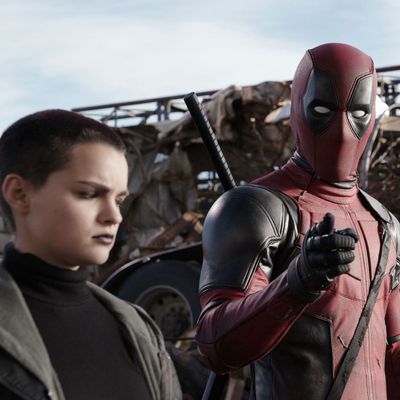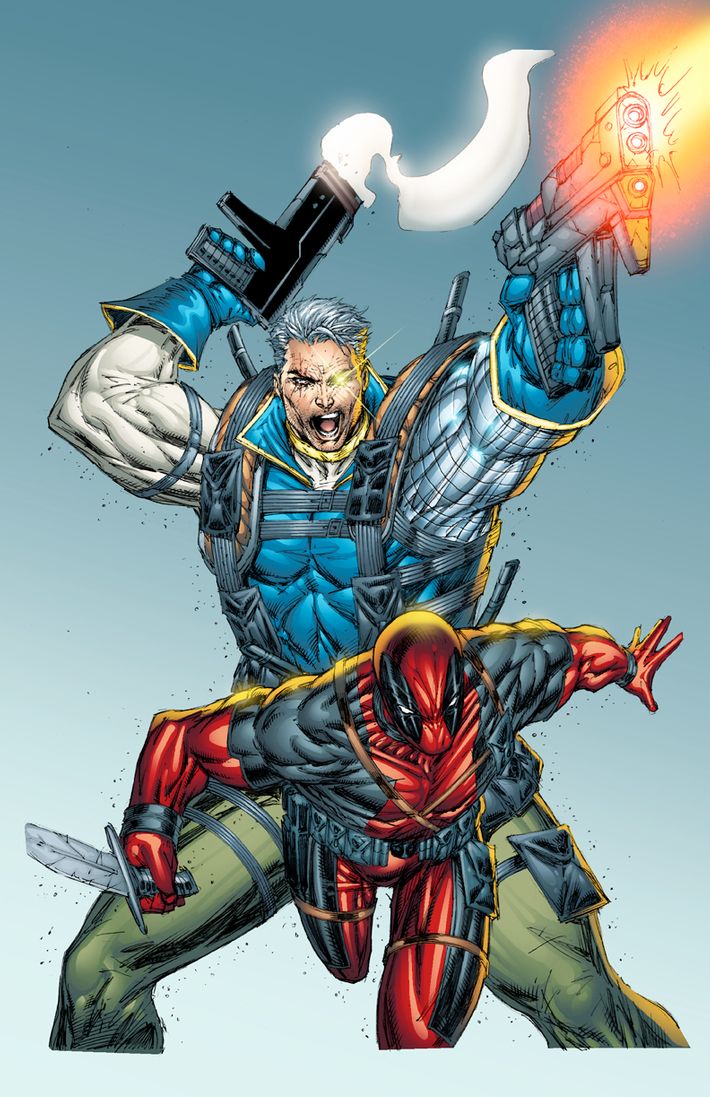
The creators of this weekend’s superhero smash Deadpool were a bunch of sneaky little sneaks when it came to the obligatory post-credits scene. Press screenings ended with a cheeky homage to the OG post-credits scene, Ferris Bueller’s Day Off’s famous “it’s over, go home” sequence, complete with ’Pool wearing a charming bathrobe. But audiences who went to the multiplex in the past few days were treated to yet another scene tacked on after that scene. Here’s the lowdown on how to interpret it if you’re a comics novice. Spoilers ahead, obviously.
The post-post-credits scene reveals that the already-in-the-works Deadpool sequel will feature a guy named Cable. If you saw the flick, you no doubt heard cheers from the geekier members of the crowd. But for those who were perplexed, here are five things you need to know about the guy.
1. He’s a time-traveling mutant soldier with mind powers.
Here’s the simple version of Cable’s backstory: He’s a muscular mutant with psychic and telekinetic abilities who traveled back in time from a distant, postapocalyptic future and fights to save the present. He has a metal arm and a glowing eye and carries a lot of comically large guns. He’s a cautious ally of the Marvel Universe’s premier mutant superteam, the X-Men.
That’s all you need to know, but X-Men continuity is infamously byzantine, so just for fun here’s his full backstory.
[Deep breath.]
He’s Nathan Summers, the son of X-Man Cyclops and a woman named Madelyne Pryor, who was a clone of Cyclops’s then-dead love interest Jean Grey. They had the kid in the present, but Nathan got infected with a “techno-organic virus” that couldn’t be cured using current technology, so Cyclops gave baby Nathan to a mysterious woman who took him into the far future (the woman later turned out to be Cyclops and Jean Grey’s child from an alternate timeline). That far future was one where X-Men villain Apocalypse (who will be introduced to the movie world in this summer’s appropriately named X-Men: Apocalypse) had taken over the world, and Nathan was raised as a savior and eventually sent back in time to the era in which he was born. He then spent years trying to fight Apocalypse in the present to prevent Apocalypse from taking over the future.
Seriously, just focus on the simple version.
2. He and Deadpool have a lot of history, both on the page and off.
Cable was introduced in 1990, within the pages of The New Mutants No. 87. The issue was written by veteran comics writer Louise Simonson and drawn and co-written by hotshot artist Rob Liefeld, so they’re both billed as the character’s co-creators. About a year later, Liefeld would go on to co-create Deadpool and introduce him. Both characters are representative of the world of early-’90s superhero comics — an artistic ecosystem where violent, heavily armed tough guys were the order of the day. Deadpool was actually introduced as someone hired to kill Cable, and his first appearance in 1991’s The New Mutants No. 98 featured him kicking the crap out of Nathan Summers. Ever since then, their paths have often intertwined — in fact, they co-starred in an ongoing monthly series called Cable & Deadpool from 2004 to 2008. Their buddy-comedy dynamic — dour soldier and wacky mercenary — is reliably delightful and will likely form the core of Deadpool 2.

3. He’s Mr. Grumpy McGrumpy Pants.
Nate is, for the most part, a humorless drag. Indeed, this fact has become a running gag — characters (especially Deadpool) love to point out that he’s eternally serious, unable to take a joke, and never satisfied with anyone else’s level of training. These traits were by design. Liefeld’s idea was to have a character who believes in saving mutantkind but thinks Charles Xavier and Magneto — the Marvel Universe’s rival leaders for the mutant community — aren’t pragmatic enough in their aims. Cable is all about results, man.
Here’s how Liefeld put it to me: “I made Cable the commando faction of the mutant universe. Given that Xavier’s kind of a pacifist and Magneto’s a fascist, I’m like, Where’s the in-between between these guys who’s more aggressive and would piss both of these guys off? He’d be more, “I know what’s coming, and we can’t sit around and act like you want to, Charles, and we can’t hurt people like you want to, Magneto.”
What a haughty guy Cable is. No wonder he has so few friends.
4. He’s a team player, sometimes.
Cable spent a good deal of his early publication history leading a task force of young mutants who were willing to fight evil by any means necessary. They were called X-Force, and they’ll likely make an appearance in a future movie in Fox’s X-Men franchise. After a while, he no longer led the squad, and he’s spent most of his time since then as a loner, albeit one who occasionally joins forces with the X-Men or the Avengers.
5. He’s had a rocky time in print.
Cable and his massive guns were wildly popular when they first entered the comics scene, and he remained a key character in the X-Men comics franchise throughout the rest of the 1990s. He even starred in a solo series, Cable, during that period. But his character ran out of steam around the turn of the millennium, when he accomplished his goal of defeating Apocalypse to prevent his dark future.
It was somewhat like what happens when a will-they-or-won’t-they coupling finally happens on a TV show: Where do you go now that the tension is gone? He remains a presence in Marvel’s comics output but does not currently have a solo series and hasn’t been a top-tier character in years. That said, if he pops up in the movies, there’s a solid chance that some brand synergy will put him back on the radar.




